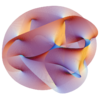G2 manifold
In differential geometry, a G2 manifold is a seven-dimensional Riemannian manifold with holonomy group contained in G2. The group [math]\displaystyle{ G_2 }[/math] is one of the five exceptional simple Lie groups. It can be described as the automorphism group of the octonions, or equivalently, as a proper subgroup of special orthogonal group SO(7) that preserves a spinor in the eight-dimensional spinor representation or lastly as the subgroup of the general linear group GL(7) which preserves the non-degenerate 3-form [math]\displaystyle{ \phi }[/math], the associative form. The Hodge dual, [math]\displaystyle{ \psi=*\phi }[/math] is then a parallel 4-form, the coassociative form. These forms are calibrations in the sense of Reese Harvey and H. Blaine Lawson,[1] and thus define special classes of 3- and 4-dimensional submanifolds.
Properties
All [math]\displaystyle{ G_2 }[/math]-manifold are 7-dimensional, Ricci-flat, orientable spin manifolds. In addition, any compact manifold with holonomy equal to [math]\displaystyle{ G_2 }[/math] has finite fundamental group, non-zero first Pontryagin class, and non-zero third and fourth Betti numbers.
History
The fact that [math]\displaystyle{ G_2 }[/math] might possibly be the holonomy group of certain Riemannian 7-manifolds was first suggested by the 1955 classification theorem of Marcel Berger, and this remained consistent with the simplified proof later given by Jim Simons in 1962. Although not a single example of such a manifold had yet been discovered, Edmond Bonan nonetheless made a useful contribution by showing that, if such a manifold did in fact exist, it would carry both a parallel 3-form and a parallel 4-form, and that it would necessarily be Ricci-flat.[2]
The first local examples of 7-manifolds with holonomy [math]\displaystyle{ G_2 }[/math] were finally constructed around 1984 by Robert Bryant, and his full proof of their existence appeared in the Annals in 1987.[3] Next, complete (but still noncompact) 7-manifolds with holonomy [math]\displaystyle{ G_2 }[/math] were constructed by Bryant and Simon Salamon in 1989.[4] The first compact 7-manifolds with holonomy [math]\displaystyle{ G_2 }[/math] were constructed by Dominic Joyce in 1994. Compact [math]\displaystyle{ G_2 }[/math] manifolds are therefore sometimes known as "Joyce manifolds", especially in the physics literature.[5] In 2013, it was shown by M. Firat Arikan, Hyunjoo Cho, and Sema Salur that any manifold with a spin structure, and, hence, a [math]\displaystyle{ G_2 }[/math]-structure, admits a compatible almost contact metric structure, and an explicit compatible almost contact structure was constructed for manifolds with [math]\displaystyle{ G_2 }[/math]-structure.[6] In the same paper, it was shown that certain classes of [math]\displaystyle{ G_2 }[/math]-manifolds admit a contact structure.
In 2015, a new construction of compact [math]\displaystyle{ G_2 }[/math] manifolds, due to Alessio Corti, Mark Haskins, Johannes Nordstrőm, and Tommaso Pacini, combined a gluing idea suggested by Simon Donaldson with new algebro-geometric and analytic techniques for constructing Calabi–Yau manifolds with cylindrical ends, resulting in tens of thousands of diffeomorphism types of new examples.[7]
Connections to physics
These manifolds are important in string theory. They break the original supersymmetry to 1/8 of the original amount. For example, M-theory compactified on a [math]\displaystyle{ G_2 }[/math] manifold leads to a realistic four-dimensional (11-7=4) theory with N=1 supersymmetry. The resulting low energy effective supergravity contains a single supergravity supermultiplet, a number of chiral supermultiplets equal to the third Betti number of the [math]\displaystyle{ G_2 }[/math] manifold and a number of U(1) vector supermultiplets equal to the second Betti number. Recently it was shown that almost contact structures (constructed by Sema Salur et al.)[6] play an important role in [math]\displaystyle{ G_2 }[/math] geometry".[8]
See also
References
- ↑ Harvey, Reese; Lawson, H. Blaine (1982), "Calibrated geometries", Acta Mathematica 148: 47–157, doi:10.1007/BF02392726.
- ↑ Bonan, Edmond (1966), "Sur les variétés riemanniennes à groupe d'holonomie G2 ou Spin(7)", Comptes Rendus de l'Académie des Sciences 262: 127–129.
- ↑ Bryant, Robert L. (1987), "Metrics with exceptional holonomy", Annals of Mathematics 126 (2): 525–576, doi:10.2307/1971360.
- ↑ Bryant, Robert L.; Salamon, Simon M. (1989), "On the construction of some complete metrics with exceptional holonomy", Duke Mathematical Journal 58 (3): 829–850, doi:10.1215/s0012-7094-89-05839-0.
- ↑ Joyce, Dominic D. (2000), Compact Manifolds with Special Holonomy, Oxford Mathematical Monographs, Oxford University Press, ISBN 0-19-850601-5.
- ↑ 6.0 6.1 Arikan, M. Firat; Cho, Hyunjoo; Salur, Sema (2013), "Existence of compatible contact structures on [math]\displaystyle{ G_2 }[/math]-manifolds", Asian Journal of Mathematics 17 (2): 321–334, doi:10.4310/AJM.2013.v17.n2.a3.
- ↑ Corti, Alessio; Haskins, Mark; Nordström, Johannes; Pacini, Tommaso (2015). "G2-manifolds and associative submanifolds via semi-Fano 3-folds". Duke Mathematical Journal 164 (10): 1971–2092. doi:10.1215/00127094-3120743. http://opus.bath.ac.uk/44698/1/g2m_duke_accepted.pdf.
- ↑ de la Ossa, Xenia; Larfors, Magdalena; Magill, Matthew (2021). Almost contact structures on manifolds with a G2 structure.
Further reading
- Becker, Katrin; Becker, Melanie; Schwarz, John H. (2007), "Manifolds with G2 and Spin(7) holonomy", String Theory and M-Theory : A Modern Introduction, Cambridge University Press, pp. 433–455, ISBN 978-0-521-86069-7.
- Fernandez, M.; Gray, A. (1982), "Riemannian manifolds with structure group G2", Ann. Mat. Pura Appl. 32: 19–845, doi:10.1007/BF01760975.
- Karigiannis, Spiro (2011), "What Is . . . a G2-Manifold?", AMS Notices 58 (4): 580–581, https://www.ams.org/notices/201104/rtx110400580p.pdf.
 |


